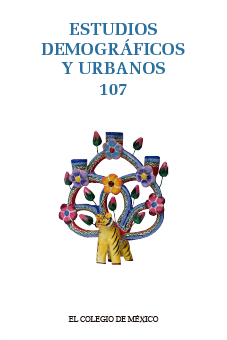Disposición al ahorro de energía eléctrica en los hogares de México
Publicado 2021-05-07
Palabras clave
- consumo de electricidad,
- consumo sustentable,
- comportamiento proecológico,
- regresión logística.
Cómo citar
-
Resumen2671
-
PDF (español)1198
-
En línea (español)47
Descargas
Derechos de autor 2021 Estudios Demográficos y Urbanos

Esta obra está bajo una licencia internacional Creative Commons Atribución-NoComercial-SinDerivadas 4.0.
Métrica
Resumen
El objetivo del trabajo consiste en identificar la disposición al ahorro de energía eléctrica que presentan los hogares de México. Para ello, se analiza un total de 2 815 hogares provenientes de la Encuesta Nacional de los Hogares, así como del Módulo Hogares y Medio Ambiente (2017). Además, se estima un modelo de regresión logística para identificar los determinantes de dicha disposición. Los resultados encontrados señalan que sólo el 50.6% de los hogares presenta una disposición al ahorro de electricidad, y que las características de la vivienda, el tamaño de la localidad, la ubicación geográfica y la compra de enseres eléctricos con cierta conciencia ecológica son determinantes para explicarla, en tanto que el precio del servicio no fue relevante. Por lo tanto, las estrategias de ahorro deben de provenir principalmente de programas que estimulen los hábitos de uso.
Referencias
- Abrahamse, W. y Steg, L. (2009). How do socio-demographic and psychological factors relate to households’ direct and indirect energy use and savings? Journal of Economic Psychology, 30, 711-720. https://www.rug.nl/staff/e.m.steg/abrahamsestegenergy.pdf DOI: https://doi.org/10.1016/j.joep.2009.05.006
- Agostini, C., Plottier, C. y Saavedra, E. (2012). La demanda residencial de energía eléctrica en Chile. Economía Chilena, 15(3), 64-83. https://si2.bcentral.cl/public/pdf/revista-economia/2012/dic/recv15n3dic2012pp64-83.pdf
- Ajzen, I. (1991). The theory of planned behavior. Organizational Behavior and Human Decision Processes, 50(2), 179-211. https://www.sciencedirect.com/science/article/abs/pii/074959789190020T DOI: https://doi.org/10.1016/0749-5978(91)90020-T
- Athukorala, W., Wilson, C., Managi, S. y Karunarathna, M. (2019). Household demand for electricity: The role of market distortions and prices in competition policy. Energy Policy, 134, 110932. https://www.sciencedirect.com/science/article/abs/pii/S0301421519305191 DOI: https://doi.org/10.1016/j.enpol.2019.110932
- Bartiaux, F. y Gram-Hanssen, K. (2005). Socio-political factors influencing household electricity consumption: A comparison between Denmark and Belgium. European Council for an Energy Efficient Economy, Panel 6. Dynamics of consumption. https://www.eceee.org/library/conference_proceedings/eceee_Summer_Studies/2005c/Panel_6/6131bartiaux/
- Börsch-Supan, A. (1990). On the compatibility of nested logit models with utility maximization. Journal of Econometrics, 43(3), 373-388. https://www.sciencedirect.com/science/article/abs/pii/030440769090126E DOI: https://doi.org/10.1016/0304-4076(90)90126-E
- Boudet H., Flora, J. y Armel, K. (2016). Clustering household energy-saving behaviours by behavioural attribute. Energy Policy, 92, 444-454. https://peec.stanford.edu/sites/g/files/sbiybj9616/f/clustering_energy_behaviors.pdf DOI: https://doi.org/10.1016/j.enpol.2016.02.033
- Brounen, D., Kok, N. y Quigley, J. (2012). Residential energy use and conservation: Economics and demographics. European Economic Review, 56(5), 931-945. https://www.sciencedirect.com/science/article/pii/S0014292112000256 DOI: https://doi.org/10.1016/j.euroecorev.2012.02.007
- Cone, J. y Hayes, S. (1985). Environmental problems. Behavioral solutions. Nueva York, NY: Cambridge University Press.
- Corral, V. (2006). Contribuciones del análisis de la conducta a la investigación del comportamiento pro-ecológico. Revista Mexicana de Análisis de la Conducta, 32, 111-127. http://journals.iztacala.unam.mx/index.php/smac/article/viewFile/51/53
- Corral, V. (2010). Psicología de la sustentabilidad: un análisis de lo que nos hace pro ecológicos y pro sociales. México: Trillas.
- Cramer, J., Miller, N., Craig, P., Hackett, B., Dietz, T., Vine, E., Levine, M. y Kowalczyk, D. (1985). Social and engineering determinants and their equity implications in residential electricity use. Energy, 10(12), 1283-1291. https://www.sciencedirect.com/science/article/abs/pii/0360544285901392 DOI: https://doi.org/10.1016/0360-5442(85)90139-2
- Dietz, T., Gardner, G., Gilligan, J., Stern, P. y Vandenbergh, M. (2009). Household actions can provide a behavioral wedge to rapidly reduce U.S. carbon emissions. Proceedings of the National Academy of Sciences, 106(44), 18452-18456. https://www.pnas.org/content/106/44/18452 DOI: https://doi.org/10.1073/pnas.0908738106
- Ek, K. y Söderholm, P. (2010). The devil is in the details: Household electricity saving behavior and the role of information. Energy Policy, 38(3), 1578-1587. https://www.sciencedirect.com/science/article/abs/pii/S0301421509008908 DOI: https://doi.org/10.1016/j.enpol.2009.11.041
- Guo, Z., Zhou, K., Zhang, C., Lu, X., Chen, W. y Yang, S. (2018). Residential electricity consumption behavior: Influencing factors, related theories and intervention strategies. Renewable and Sustainable Energy Reviews, 81(1), 399-412. https://www.sciencedirect.com/science/article/abs/pii/S1364032117311164 DOI: https://doi.org/10.1016/j.rser.2017.07.046
- Henry, M. L., Ferraro, P. J. y Kontoleon, A. (2019). The behavioural effect of electronic home energy reports: Evidence from a randomised field trial in the United States. Energy Policy, 132, 1256-1261. https://www.sciencedirect.com/science/article/abs/pii/S0301421519304094 DOI: https://doi.org/10.1016/j.enpol.2019.06.039
- Houthakker, H. (1951). Some calculations on electricity consumption in Great Britain. Journal of the Royal Statistical Society, 114, 359-371. https://rss.onlinelibrary.wiley.com/doi/epdf/10.2307/2980781 DOI: https://doi.org/10.2307/2980781
- Inglehart, R. (1997). Modernization and postmodernization: Cultural, economic, and political change in 43 societies. Princeton, NJ: Princeton University Press. DOI: https://doi.org/10.1515/9780691214429
- INEGI (Instituto Nacional de Estadística y Geografía) (2018a). Módulo de Hogares y Medio Ambiente 2017. México: INEGI. https://www.inegi.org.mx/programas/mohoma/2017/
- INEGI (Instituto Nacional de Estadística y Geografía) (2018b). Encuesta Nacional de los Hogares 2017. México: INEGI. https://www.inegi.org.mx/programas/enh/2017/
- Jevons, W. S. (1865). The coal question; an inquiry concerning the progress of the nation, and the probable exhaustion of our coal mines. Reino Unido: Macmillan Publishers.
- Karlin, B., Davis, N., Sanguinetti, A., Gamble, K., Kirkby, D. y Stokols, D. (2014). Dimensions of conservation: Exploring differences among energy behaviors. Environment and Behavior, 46(4), 423-452. https://journals.sagepub.com/doi/10.1177/0013916512467532 DOI: https://doi.org/10.1177/0013916512467532
- Laicāne, I., Blumberga, A., Rošā, M. y Blumberga. D. (2014). Determinants of household electricity consumption savings: A Latvian case study. Agronomy Research, 12(2), 527-542. https://agronomy.emu.ee/wp-content/uploads/2014/05/2014_2_24_b5.pdf
- Larios, A. (2014). La energía renovable en México: perspectivas desde el Balance Nacional de Energía 2012. Economía Informa, 385, 90-99. http://www.economia.unam.mx/assets/pdfs/econinfo/385/07lariosvazquez.pdf DOI: https://doi.org/10.1016/S0185-0849(14)70423-2
- Leahy, E. y Lyons, S. (2010). Energy use and appliance ownership in Ireland. Energy Policy, 38(8), 4265-4279. https://www.sciencedirect.com/science/article/abs/pii/S0301421510002193 DOI: https://doi.org/10.1016/j.enpol.2010.03.056
- Lezama, J. L. (2014). Política energética y sustentabilidad. La estrategia mexicana de ahorro y eficiencia de energía eléctrica en los hogares y la experiencia internacional. Ciudad de México: El Colegio de México, A.C.
- Morales, D. y Luyando, J. (2016). Actitudes y conocimientos en el consumo de electricidad domiciliaria. Ciencia UANL, 77, 46-50. http://cienciauanl.uanl.mx/wp-content/uploads/2016/03/art.-DDE-LA-CFE.pdf
- Mcloughlin, F., Duffy, A. y Conlon, M. (2012). Characterising domestic electricity consumption patterns by dwelling and occupant socio-economic variables: An Irish case study. Energy Build, 48(19), 240-248. https://arrow.tudublin.ie/cgi/viewcontent.cgi?article=1056&context=dubenart DOI: https://doi.org/10.1016/j.enbuild.2012.01.037
- Muljono, W. (2016). Electricity energy saving in Indonesia households: A look at communication campaign programs and the importance of environmental attitudes to help address the electricity crisis. Environmental Management and Sustainable Development, 5(2), 204-228. http://www.macrothink.org/journal/index.php/emsd/article/view/9817 DOI: https://doi.org/10.5296/emsd.v5i2.9817
- Ouyang, J. y Hokao, K. (2009). Energy-saving potential by improving occupants’ behavior in urban residential sector in Hangzhou City, China. Energy and Buildings, 41(7), 711-720. https://www.sciencedirect.com/science/article/abs/pii/S0378778809000267 DOI: https://doi.org/10.1016/j.enbuild.2009.02.003
- Özkan, H. A. (2016). Appliance based control for home power management systems. Energy, 114, 693-707. https://www.infona.pl/resource/bwmeta1.element.elsevier-15f84557-ea31-3806-84d5-d3328263a17c DOI: https://doi.org/10.1016/j.energy.2016.08.016
- Poznaka, L., Laicane, I., Blumberga, D., Blumberga, A. y Rosa, M. (2015). Analysis of electricity user behavior: Case study based on results from extended household survey. Energy Procedia, 72, 79-86. https://www.sciencedirect.com/science/article/pii/S187661021500702X DOI: https://doi.org/10.1016/j.egypro.2015.06.012
- Saidur, R., Masjuki, H. H. y Jamaluddin, M. Y. (2007). An application of energy and exergy analysis in residential sector of Malaysia. Energy Policy, 35(2), 1050-1063. https://www.sciencedirect.com/science/article/abs/pii/S0301421506000930 DOI: https://doi.org/10.1016/j.enpol.2006.02.006
- Sardianou, E. (2007). Estimating energy conservation patterns of Greek households. Energy Policy, 35(7), 3778-3791. https://www.sciencedirect.com/science/article/abs/pii/S0301421507000262 DOI: https://doi.org/10.1016/j.enpol.2007.01.020
- Sener (Secretaría de Energía). (2018). Prospectiva del Sector Eléctrico 2018-2032. Ciudad de México: Sener. https://base.energia.gob.mx/Prospectivas18-32/PSE_18_32_F.pdf
- Shrum, L., McCarty, J. y Lowrey, T. (1995). Buyer characteristics of the green consumer and their implications for advertising strategy. Journal of Advertising, 24(2), 71-82. https://www.jstor.org/stable/4188973?seq=1 DOI: https://doi.org/10.1080/00913367.1995.10673477
- Stern, P. (2000). New environmental theories: Toward a coherent theory of environmentally significant behavior. Journal of Social Issues, 56(3), 407-424. https://spssi.onlinelibrary.wiley.com/doi/abs/10.1111/0022-4537.00175 DOI: https://doi.org/10.1111/0022-4537.00175
- Van den Broek, K. L., Walker, I. y Klöckner, C. (2019). Drivers of energy saving behaviour: The relative influence of intentional, normative, situational and habitual processes. Energy Policy, 132, 811-819. https://www.sciencedirect.com/science/article/abs/pii/S0301421519304124 DOI: https://doi.org/10.1016/j.enpol.2019.06.048
- Van Raaij, W. F. y Verhallen, T. M. (1983). A behavioral model of residential energy use. Journal of Economic Psychology, 3(1), 39-63. https://www.cbsm.com/articles/31777-a-behavioral-model-of-residential-energy-use DOI: https://doi.org/10.1016/0167-4870(83)90057-0
- Vergés, J. (2009). Mercado eléctrico, regulación y alternativas tecnológicas. Business Economy and Governments. Barcelona, España. http://webs2002.uab.es/jverges/Assaig%20pdf/Mercado%20eléctrico,%20regulación%20y%20alternativas%20tec.pdf
- Vicéns, J. (2008). La demanda de electricidad en España: importancia del sector residencial y estrategias de gestión activa. En Energía. Una visión económica (pp. 299-328). Madrid: Club Español de la Energía / Instituto Español de la Energía.
- Wang, Z., Zhang, B., Yin, J. y Zhang, Y. (2011). Determinants and policy implications for household electricity-saving behavior: Evidence from Beijing, China. Energy Policy, 39(6), 3550-3557. https://doi.org/10.1016/j.enpol.2011.03.055 DOI: https://doi.org/10.1016/j.enpol.2011.03.055
- Yohanis Y. G., Mondol, J. D., Wright, A. y Norton, B. (2008). Real-life energy use in the UK: How occupancy and dwelling characteristics affect domestic electricity use. Energy and Buildings, 40(6), 1053-1059. https://www.sciencedirect.com/science/article/abs/pii/S037877880700223X?via%3Dihub DOI: https://doi.org/10.1016/j.enbuild.2007.09.001
- Zhang, Y., Wang, Z. y Zhou, G. (2014). Determinants of employee electricity saving: The role of social benefits, personal benefits and organizational electricity saving climate. Journal of Cleaner Production, 66(1), 280-287. https://www.sciencedirect.com/science/article/pii/S0959652613006975 DOI: https://doi.org/10.1016/j.jclepro.2013.10.021



